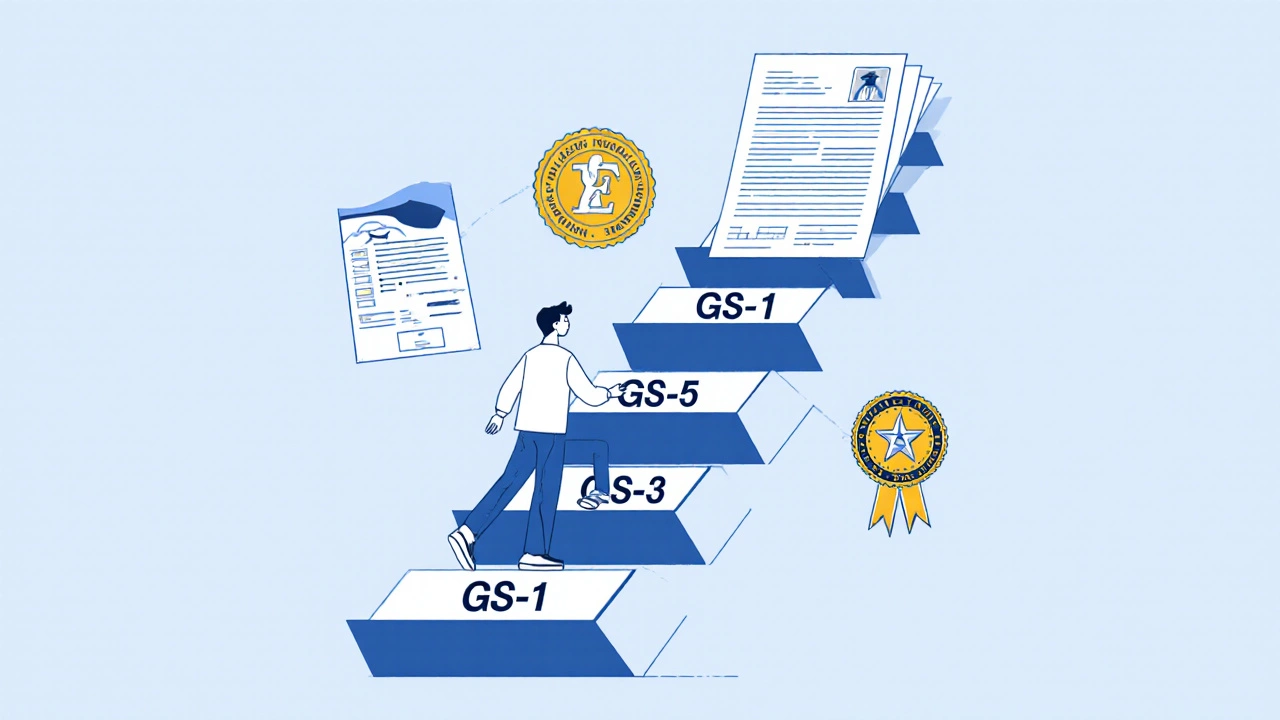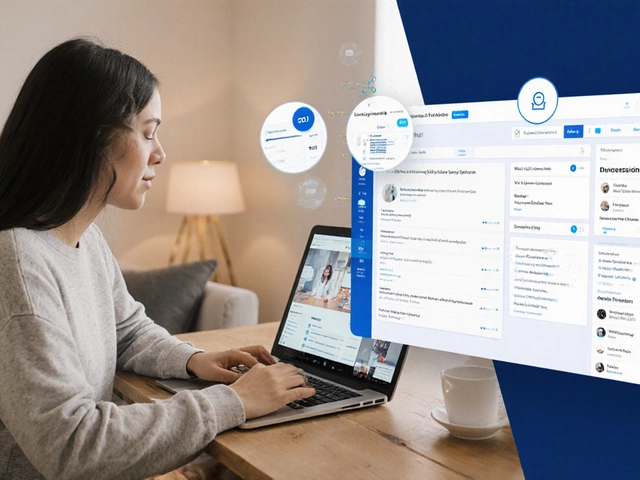Federal Pay Calculator
Estimate Your Federal Salary
Calculate your potential earnings for federal government positions based on grade, location, and hours worked.
Enter your details to see your estimated salary
The federal government hires over 2 million people across hundreds of roles - from cybersecurity specialists to park rangers, from postal workers to data clerks. But if you’re looking at the bottom of the pay scale, the answer isn’t what most people expect. The lowest paying federal job isn’t some obscure role tucked away in a basement office. It’s the GS-1 position, specifically the Student Trainee role, often filled by high school students or recent graduates working part-time under the Pathways Program.
What Exactly Is a GS-1 Position?
The General Schedule (GS) pay system is how the U.S. federal government sets salaries for most white-collar civil service jobs. It has 15 grades, from GS-1 (lowest) to GS-15 (senior executive). Each grade has 10 steps, with pay increasing slightly with time and performance.
A GS-1 position is the entry point. These roles don’t require a college degree - sometimes not even a high school diploma. They’re designed for people learning the ropes. Most GS-1 jobs are part-time, temporary, or work-study roles. You might file paperwork, answer phones, scan documents, or help in a library or administrative office. The work is simple, repetitive, and supervised closely.
In 2025, the base annual salary for a GS-1, Step 1, in the continental U.S. is $21,877. That’s about $10.51 per hour for a 40-hour workweek. If you work part-time - say 20 hours a week - your pay drops to roughly $10,938 per year. That’s below the federal poverty line for a single person in most states. But here’s the catch: these jobs aren’t meant to be long-term careers. They’re stepping stones.
Why Do These Jobs Even Exist?
The federal government doesn’t hire GS-1 workers just to save money. It’s a legal and practical tool to bring in young people, students, and those with limited experience. The Pathways Program, run by the Office of Personnel Management (OPM), is designed to build a pipeline of future federal employees. Many GS-1s are high school seniors doing summer work or college students on work-study.
These roles give people their first taste of government work. They learn how to use federal systems, follow rules, and handle public records. After six months to a year, many move up to GS-3 or GS-4 positions - often with a raise of 20% or more. Some even qualify for full-time roles after graduation.
It’s not a job you stay in. It’s a job you use to get your foot in the door.
Where Are These Jobs Located?
You won’t find GS-1 jobs in big cities like Washington, D.C., or New York - not usually. They’re common in smaller federal offices: local post offices, rural IRS branches, small Veterans Affairs clinics, national park visitor centers, and school-based federal programs.
For example, a high school student in rural Nebraska might work 15 hours a week at the local Social Security office, sorting mail and helping with data entry. A college freshman in Mississippi might be hired by the USDA to assist with farm subsidy paperwork. These jobs are often posted on USAJobs.gov under titles like:
- Student Trainee (Administrative)
- Student Intern (Clerical)
- Work-Study Assistant
Location matters. Pay is adjusted by locality. A GS-1 in Alaska or Hawaii earns more than one in Mississippi. But even with locality pay, the base remains low. The real value isn’t in the paycheck - it’s in the experience.

How Does This Compare to Other Entry-Level Jobs?
Let’s put this in perspective. The federal minimum wage is $7.25 an hour. Many private-sector entry-level jobs pay $12-$15 an hour - even without a degree. So why would anyone take a GS-1 job?
Because federal jobs offer something private employers rarely do: stability and a clear path forward.
Once you’re on the federal payroll, you’re eligible for:
- Health insurance (even part-time)
- Retirement benefits (FERS or CSRS)
- Annual and sick leave
- Flexible work schedules
- Training and tuition assistance
And here’s the kicker: after 90 days of continuous service, you can apply for other federal jobs without competing against the public. You’re already a federal employee. That’s a huge advantage.
Compare that to a fast-food job or retail clerk position. No health benefits. No retirement plan. No clear promotion path. A GS-1 job might pay less now, but it opens doors that private-sector jobs don’t even have.
Who Typically Takes These Jobs?
Most GS-1 workers are under 25. They’re students, recent graduates, or people transitioning into their first career. Some are veterans’ family members. Others are from low-income households looking for a stable, safe environment to start.
There’s also a quiet demographic: people with disabilities. The federal government is one of the largest employers of people with disabilities in the U.S. Many GS-1 roles are designed to be accessible - quiet, low-stress, and structured. They offer a low-pressure way to gain confidence and skills.
These jobs aren’t glamorous. But for someone with no work history, no degree, or no connections, they’re one of the few reliable ways to get started.

How to Get a GS-1 Job
Applying is easier than you think. You don’t need a resume with years of experience. You don’t need to pass a test. You just need to show up.
Here’s how:
- Go to USAJobs.gov
- Search for “Student Trainee” or “Work-Study”
- Filter by “Part-Time” and “Entry Level”
- Look for positions near your school or home
- Apply with a simple resume - even a list of classes and volunteer work works
You’ll need to fill out a federal application form (OF-612 or online equivalent). It’s longer than a private-sector form, but it’s straightforward. Most hiring managers review applications within 3-4 weeks.
Don’t wait for perfect qualifications. If you can type 40 words per minute, show up on time, and follow instructions, you’re qualified.
What Comes After GS-1?
Most people don’t stay at GS-1. The goal is to move up - fast.
After six months, you can apply for GS-3 positions. These require a high school diploma or equivalent. Pay jumps to around $27,000 annually. After a year, you might qualify for GS-4 or GS-5 - roles that require some college credits or experience. GS-5 is where many full-time careers begin: data analysts, administrative assistants, or customer service reps.
Some people use GS-1 as a springboard to get into college. The federal government offers tuition assistance programs for employees. You can take online classes while working part-time and have your tuition paid for - if you stay on the job for two years.
It’s not a fast track to wealth. But it’s a reliable, low-risk path to stability.
Is It Worth It?
If your goal is to make the most money possible right now - no, it’s not worth it. You’ll earn less than a cashier at Walmart.
If your goal is to build a long-term career with benefits, security, and upward mobility - then yes. A GS-1 job is the cheapest, safest, and most structured way to enter the federal workforce.
Think of it like a first job at a big company: low pay, but you learn the system. You meet people. You get references. You earn a government badge. You become someone who’s already “in.”
And in government hiring, that’s everything.




